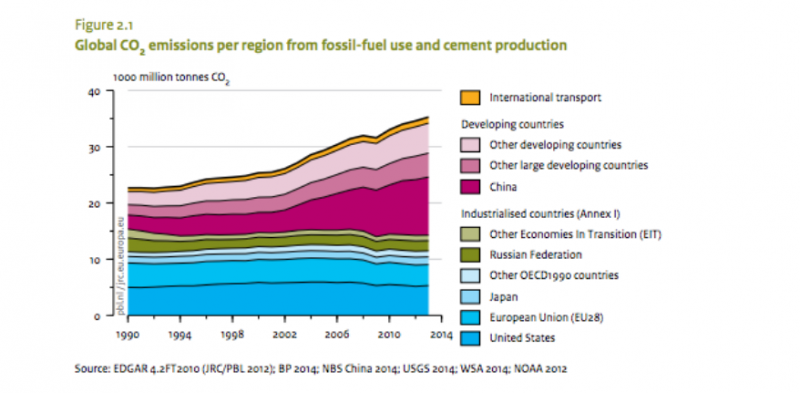By Erica Dingman
The field of science is known for expressing caution with the interpretation of its findings, but this is for a good reason. Scientific reports are couched in terms of ‘uncertainty,’ ‘likely,’ and ‘high, medium, or low confidence’ – nothing in life is guaranteed. So I was astonished to read a statement made by Christophe McGlade and Paul Ekins in the journal Nature: “We show that development of resources in the Arctic and any increase in unconventional oil production are incommensurate with efforts to limit average global warming to 2 °C. Our results show that policy makers’ instincts to exploit rapidly and completely their territorial fossil fuels are, in aggregate, inconsistent with their commitments to this temperature limit.”
Indeed, the global inventory of CO2 emissions have continued to rise, primarily as a result of fossil fuel combustion, and the production of cement and metals. Though lower than the average over the past decade, the PBL Netherlands Environmental Assessment Agency showed that the 2013 emissions inventory grew by 2 percent compared to 2012. Yet, fossil fuel exploration continues in the Arctic where it’s estimated that 75 percent of oil and gas potential is offshore and 25 percent onshore, according to a recent report by the National Petroleum Council. This is the same as 479 billion barrels of oil equivalent potential, which if developed would release additional CO2 emissions into the atmosphere through processes of combustion in power and heat generation.
Arctic fossil fuel development may not, however, be the panacea sometimes imagined. Last December, Chevron Canada shelved plans to drill exploratory wells in the Beaufort Sea citing “Economic uncertainty in the industry” as a factor. Since August 2014, the price of crude oil plummeted from over US$100 a barrel and has hovered around US$40 since December. Then in June 2015, Imperial Oil and its partners Exxon Mobil Corp and BP followed suit asking for an extension to their exploration license in the region.
In part, this is a result of what drillers consider a complicated regulatory regime in Canada’s Arctic. The extent to which Arctic oil resources are developed remains uncertain. Dennis Bevington, a member of Canada’s Parliament, representing the Northwest Territories, thinks it “unlikely” that Arctic oil resources will be developed to any great degree, though “Russia may do a little bit, but prices will be out of line.”
Gas, however, “may hold out a little longer” because of the inherent link between producer and consumer, says Bevington. But the politics of pipelines have their own challenges – think of the XL Keystone pipeline, which aims to further connect the Alberta oil sands with markets in the U.S. Canada has had its share of pipeline issues. Beyond Keystone, the Mackenzie Gas Project pipeline was shelved – though the project received National Energy Board (NEB) approval in 2011. Bevington points out that “the shale gas revolution [in the U.S.] killed that plan” when it pushed prices too low. The Mackenzie project, which has been indefinitely shelved, is planned as a conduit for gas drawn from the Beaufort coast in Canada’s Northwest Territories to connect gas fields with North American markets.
Sanjay Chaturvedi, Professor at Punjab University in India and a seasoned expert in Arctic issues, concurs with McGlade and Ekins that the development of Arctic hydrocarbons is problematic. “The ‘Arctic Paradox’ (fossil fuels that are among the major ‘culprits’ in the context of global warming and climate change now proving to be one of the key catalysts for the renewed geopolitical and geo-economic interest in the Circumpolar North) seems to suggest the following.” He suggests that “the opportunity offered by the challenge of climate change to think differently about ‘development’ and ‘energy security’ (concepts/understandings driven and dictated largely by what some scholars have thoughtfully described as ‘carboniferous capitalism’) is unfortunately withering away.”
In some respects, the Arctic is a metaphorical ‘battleground’ for development and energy security. Yet where the Arctic clearly shows the signs of global warming, the thirst for fossil fuels supports an economic regime that has been deemed unsustainable for future generations. Divesting from fossil fuels requires a new outlook on the global economic model, but reaching the necessary renewable energy capacity to fill our power and energy needs will take some time.
This is an argument that has been made, for example, from China to Greenland. With a predominately Inuit citizenry, the Greenlandic people are in a heated debate as to the type (for example, uranium) and scale of the nation’s hydrocarbon and mineral wealth. If developed, these subsurface resources, which are valued commodities in the global marketplace, could provide a pathway to economic independence from the Kingdom of Denmark. Notably, however, hydropower provides Greenland with approximately 70 percent of its energy needs, and other renewables are being used to a lesser degree.
Bevington views the transition to renewable energy sources as a viable solution. “In Texas, a solar company signed a contract for 4 cents an hour” and anticipates 2 cents an hour, he said. “These solar companies are signing on with big companies.” From here, Bevington sees ‘big changes’ on the horizon: “As we change the energy form many of these [non-renewable] resources will stay in the ground… We’ve developed affordable renewables now we have to develop the technology. That’s where the electric car comes into play.”
When world leaders convene in Paris for the UN Climate Change Conference – known as COP 21 – in December 2015, the overarching goal of the Convention is to adopt a “new instrument” on limiting the global temperature increase to 2°C above pre-industrial levels. To achieve this goal, all nations party to the UN Framework Agreement on Climate Change (UNFCCC) were required to submit a plan of the efforts they intend to take to meet their commitment to the 2°C goal.
The road, however, to Paris has been long and arduous. In 1975, economist William Nordhouse expressed the “first intuition” that the global temperature should not exceed 2°C above the pre-industrial level. In 1992, the UNFCCC was signed at Rio, committing nations to stabilizing “greenhouse gas concentrations in the atmosphere at a level that would prevent dangerous anthropogenic interferences with the climate system.” In 2010, the UNFCCC Cancun Agreement committed governments to “hold the increase in global average temperature below 2°C above pre-industrial levels.”
I will leave you to decide for yourself as to whether the time is long overdue for global leaders to put into action the procedures required to cut emissions. But, as economist Peter F. Drucker said in his famous 1994 article The Theory of the Business penned for The Harvard Business Review, “A degenerative disease will not be cured by procrastination. It requires decisive action.”
*****
*****
Erica Dingman is a senior research fellow at World Policy Institute and directs the Arctic in Context initiative.
[Photo Courtesy of Wikimedia Commons]

